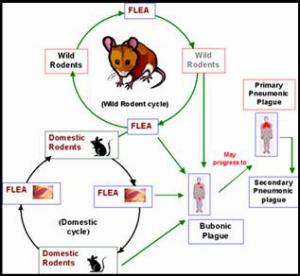Bubonic plagueOregon teen infected with bubonic plague
Health authorities in Crook County, Oregon, confirmed that a teenage girl has contracted bubonic plague from a flea while on a hunting trip. The girl became sick five days after the trip started on 16 October; and was rushed to a hospital in Bend, Oregon on 24 October.

Cycle of plague spread // Source: columbia.edu
Health authorities in Crook County, Oregon, confirmed that a teenage girl has contracted bubonic plague from a flea while on a hunting trip. The girl became sick five days after the trip started on 16 October; and was rushed to a hospital in Bend, Oregon on 24 October.
Plague is an infectious bacterial disease which is carried by rodents and spread by their fleas. It is treated with antibiotics, but to be effective the antibiotics should be administered early. A plague vaccine is not widely available, but the Food and Drug Administration (FDA) has licensed one vaccine for use in the United States
Oregon health officials say the teen is recovering in the hospital’s intensive care unit, but offer no detail of her condition.
The Sacramento Bee reports that it is likely the girl has contracted the plague near Heppner in Morrow County, in north-central Oregon. State and federal agencies have been investigating the case, but say that so far there have been no reports of other infections.
—————————————————————————————————————-
Also read:
“Long-held theory on how bacteria causes bubonic plague overturned,” HSNW, 18 March 2015
“John Tull, whose 2002 bubonic plague illness raised bioterrorism fears, dies,” HSNW, 2 July 2014
“Chinese authorities seal off city after bubonic plague death last week,” HSNW, 22 July 2014
—————————————————————————————————————-
The Centers for Disease Control and Prevention (CDC) notes that only one type of bubonic plague —pneumonic plague – is contagious and able to spread through droplets in the air. Pneumonic bubonic plague thus requires strict isolation of patients, but other types of the plague do not.
The Bee quotes the state’s Health Authority to say that in the past twenty years there have been eight human cases of bubonic plague Oregon, none fatal. The CDC notes that, on average, seven new cases of plague infection are reported each year in the United States, but that there are spikes. For example, last year there were four cases of the plague reported in Colorado in one week.
“Many people think of the plague as a disease of the past, but it’s still very much present in our environment, particularly among wildlife,” says Dr. Emilio DeBess, a veterinarian in Oregon’s Public Health Division. “Fortunately, plague remains a rare disease, but people need to take appropriate precautions with wildlife and their pets to keep it that way.”
Plague symptoms include fever and headache and painfully swollen and inflamed lymph nodes — or buboes.
The CDC says that the normal incubation period for plague is from one to six days after the initial infection.
Before antibiotics became available, the mortality rate for plague patients was 66 percent, the CDC says. In the last twenty years that number fell to 11 percent.
